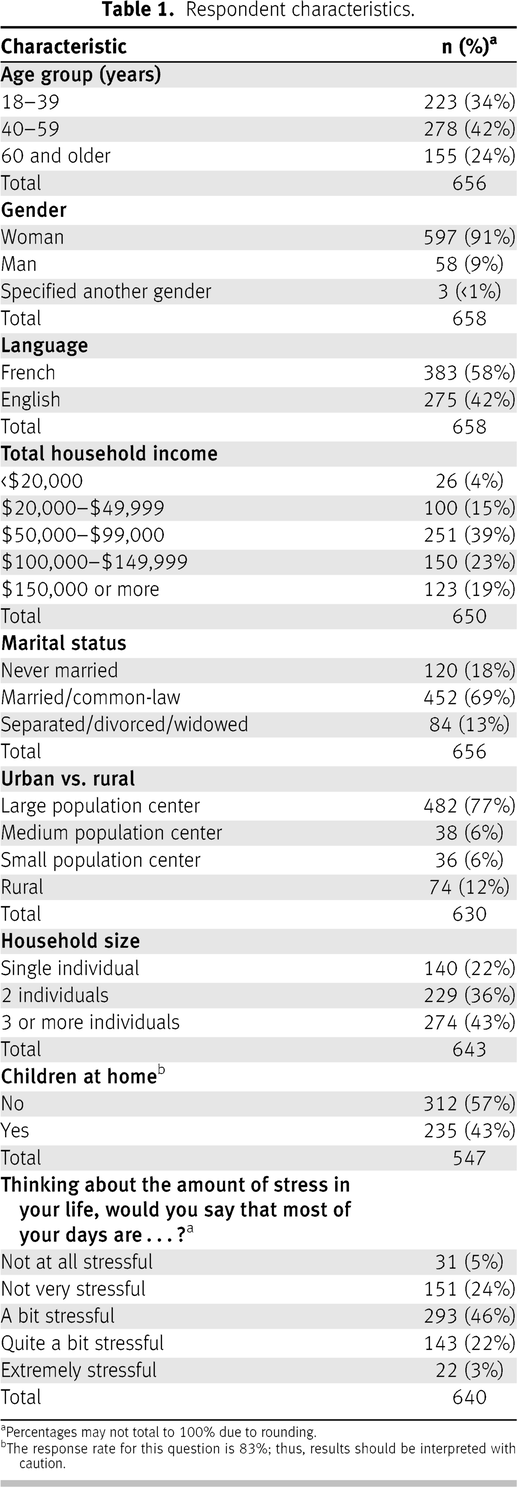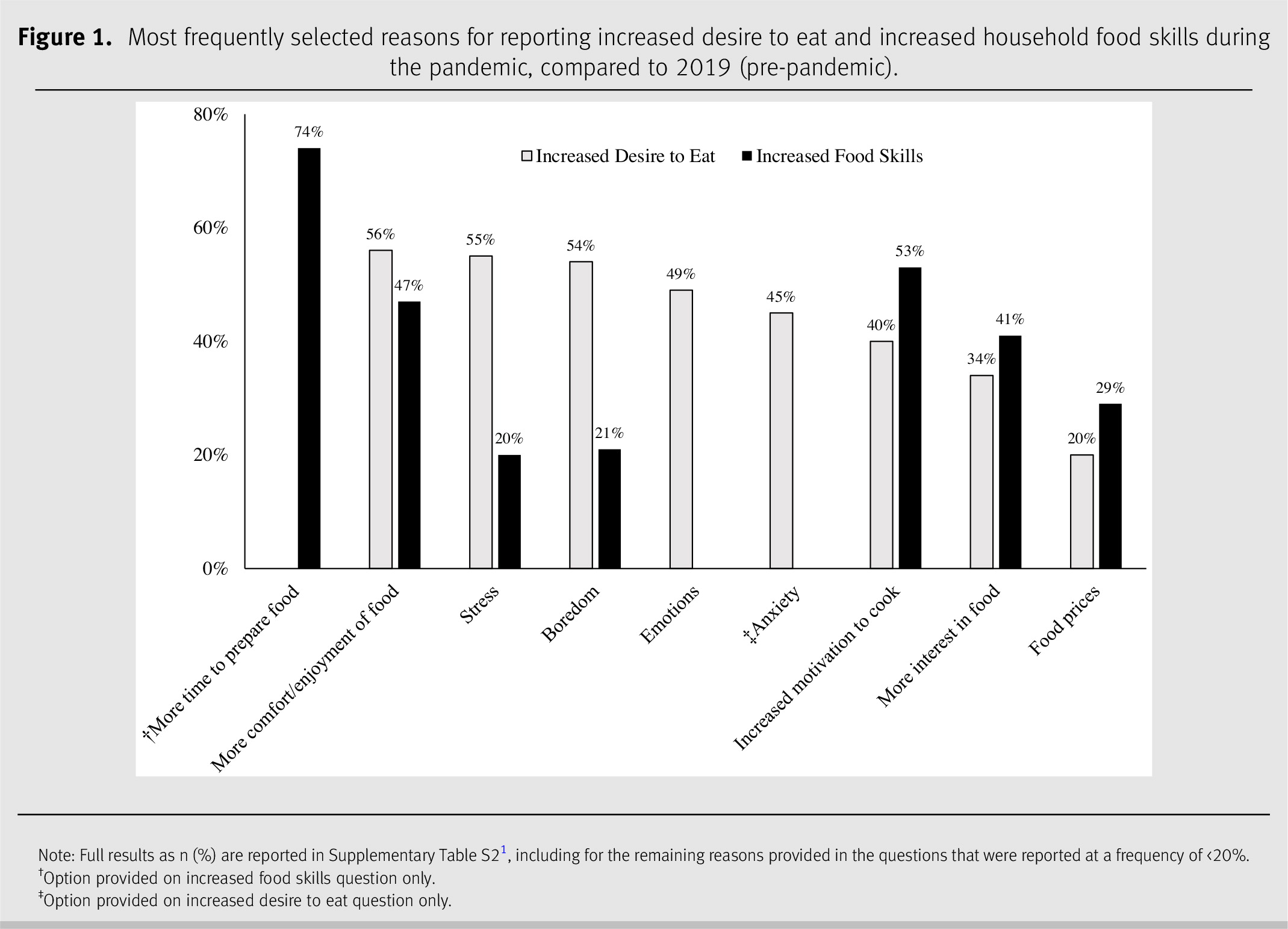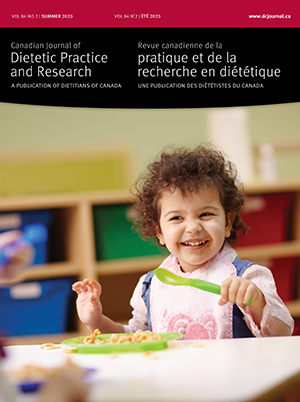INTRODUCTION
The COVID-19 pandemic has changed daily life around the globe. Restrictions to control the spread of the SARS-CoV-2 virus, such as working from home and closure of non-essential services (including schools), have had extensive unintended socioeconomic impacts [
1,
2]. Quebec was the Canadian epicentre at the start of the pandemic and the province imposed a lockdown between 13 March and 4 May 2020 (see Supplementary Material
1 for further resources on the timeline of the pandemic in Quebec). Residents were instructed to remain home and limit trips for essential items, such as food. The first wave of the pandemic in Quebec began to subside in late May 2020 and public health restrictions were eased during the provincial deconfinement period (i.e., easing out of the lockdown) that began in the summer.
Individual behaviours and perceptions related to food are important to evaluate during the COVID-19 pandemic, as the unique societal experiences of social distancing and isolation likely impacted complex factors connected to food intake including food access and psychosocial determinants of eating (for example, stress [
3]). Current evidence on eating behaviours during the pandemic are mixed with both positive and negative impacts being reported, often within the same study sample [
4–
10]. However, while previous investigations have evaluated diet quality and intake, important practical and psychosocial considerations that can influence eating behaviour have been largely unexplored, including grocery spending, food skills, food values, desire to eat, and stress. Due to the unprecedented nature of the COVID-19 pandemic, investigations of the broader set of factors connected to food and eating are warranted.
We previously reported a reduction in the frequency of in-store grocery shopping and increased use of online grocery ordering during the first wave of the pandemic among a sample of Quebec households that responded to an online survey [
11,
12]. This present investigation aimed to evaluate reported changes in food-related (food values, food skills, and grocery spending) and eating-related (desire to eat and eating amount) outcomes during the pandemic as compared to 2019 among participants who responded to a follow-up survey. Since stress has been consistently linked with eating behaviour [
3], we also assessed respondent stress level and hypothesized that those with higher reported stress would report greater changes in their desire to eat and eating amount during the pandemic.
METHODS
Detailed methods for the survey have been reported elsewhere [
11]. Briefly, an open online survey was initially conducted during the lockdown period in Quebec in May 2020. Participants were recruited through radio and digital media advertisements, social media campaigning, e-mail listservs, and word of mouth. A follow-up survey was collected in August 2020, after the provincial deconfinement period and prior to the onset of the pandemic’s second wave. The surveys were developed by the research team, comprised of nutrition and food environment investigators, and were available in English and French. The follow-up survey consisted of up to 36 questions, depending on the number of applicable follow-up questions. However, the present report is focused on results from 15 questions (two open-ended) that queried the outcomes of interest to this analysis (see Supplementary File
1 for Survey Questions). Ethics approval was obtained from the McGill University Faculty of Agriculture and Environmental Sciences Research Ethics Board (#20-05-021). As per ethics requirements, all questions were optional. Thus, minor variations in sample sizes across questions occur due to non-response.
Changes in food values (Survey Q1; “more important”, “less important”, “no change”) were assessed using the 11 items from Lusk and Briggeman’s food values scale, which has been validated against grocery scanner data of food purchasing among a consumer panel of households in the United States of America [
13,
14]. Two additional items of interest to the present investigation were included (purchasing from local retailers and food product brand). Changes in food product purchasing (Q2; “purchased more”, “purchased less”, “no change”) were evaluated using 21 food categories commonly found in grocery scanner data [
15,
16]. Weekly grocery budget in 2019 (Q3) was assessed using increments of $50 based on the most recent Statistics Canada estimate of household food spending (approximately $119/week in 2016) [
17]. Grocery budget change since the start of the pandemic was assessed with “decreased”, “did not change”, or “increased” options (Qs 4 and 5).
Survey items also evaluated changes in desire to eat (Qs 6–8), food skills in the household (Qs 9–11; definition provided on survey [
18,
19]), eating amount (Q12; “eat more than you usually do”, “eat less than you usually do”, “no change”), and food interests/actions (Q13) (response options for Qs 6–11 and Q13: “increased”, “decreased”, “no change”). Follow-up questions were included for the desire to eat (Q7) and food skills (Q10) items to identify reasons for reported changes, which included 16 options such as stress, emotions, time, motivation, and media influences (social or other). Moreover, two open-ended questions were included for respondents to describe reasons for changes in their own words (Q8 and Q11). Stress was evaluated with two items from the 2020 Canadian Community Health Survey (Annual Component) (Qs 14 and 15): (
i) a 5-point scale on daily stress level and (
ii) an 8-item sources of stress question [
20]. Items evaluating changes in outcomes were framed with the text “Compared to the year before COVID-19 (2019)…”.
Statistical analysis
Descriptive statistics were calculated to report frequency (%) of responses using available data per survey item and mean and standard deviation for change in grocery budget. For comparisons by stress level, the 5-point scale on daily stress was collapsed into three levels (Not at all stressful and Not very stressful: “Low stress”; A bit stressful: “Some stress”; Quite a bit stressful and Extremely stressful: “High stress”). Cochran–Armitage test for trend was used to compare patterns of responses for changes in eating outcomes by the 3-level stress variable. Free text responses to open-ended items were evaluated by two investigators (DEN and KL) using thematic analysis [
21]. Responses were read several times by DEN to identify themes with an inductive approach and propose categories. KL reviewed and together they both developed a coding frame and finalized categories. DEN performed categorization, which KL reviewed. Review of the initial categorization yielded 94% consensus. Discrepancies were discussed and 100% consensus was achieved. Themes that were unique from the list of options provided and that were reported by ≥5 respondents are presented in the results.
RESULTS
Among 1056 participants who consented to being contacted for follow-up, 658 (62%) consented to this survey and 633 responded to the last question (96% completion). Characteristics of the present sample aligned with those of the respondents who completed the baseline survey [
11]. Respondents were primarily females residing in large urban areas with mid-to-high household incomes. The majority were married/common-law and the most prevalent household size was 3 or more individuals (
Table 1). Most participants reported that their days were a bit stressful and one-quarter reported high stress. Work, health, and family were the most frequently reported sources of stress (Supplementary Table S1
1).
Food values, purchasing and spending
Compared to 2019, the food values that were most selected as gaining importance were purchasing food from local retailers (77%) and country of origin of food products (68%) (
Table 2). Safety, environmental impact, price, ethical impact, naturalness, and brand of food products were also selected as gaining importance, but to a lesser extent (23%–48%). The remaining food values were relatively unchanged (nutritional value, convenience, taste, appearance, and tradition). The most noticeable reported change in food product purchasing compared to 2019 was for local food products (65% purchased more), while changes to all other food products were mixed. Subsets of respondents reported more purchasing (32%–40%) of frozen/shelf-stable items (canned or dried goods, baking products, alcohol, chips or other salty snacks, frozen fruits and vegetables) and some reported less purchasing (17%–26%) of fresh and frozen prepared meals, meat products, sweet snacks and desserts, and carbonated beverages with sugar (
Table 2). The most selected weekly grocery budget in 2019 was $100–$149/week and most participants (60%) reported that their grocery spending increased compared to 2019 (
Table 3). Among those who reported an increase, the mean ± standard deviation increase in food spending was 28% ± 23% (range: 5%–175%, mode: 20%).
Eating, food skills, and food interests
Compared to 2019, 28% of participants reported an increase in their desire to eat and 32% said they eat more than they usually do compared to 2019 (
Table 3). The most selected factors (item response frequency >40%) that reportedly played a role in increased desire to eat were more comfort/enjoyment of food, stress, boredom, emotions, and anxiety (
Figure 1 and Supplementary Table S2
1). Free-text analysis revealed four additional themes, which were being at home and around food more often, increased cravings/snacking, a need to eat all meals with children who were at home, and health consciousness. See Supplementary Table S3
1 for selected free-text responses from each theme. Eight percent of respondents reported that their desire to eat decreased and 12% reported that they eat less than they usually do. The most selected factors (item response frequency >40%) for a decreased desire to eat were stress, anxiety, and decreased motivation to cook (Supplementary Table S4
1). Free-text analysis revealed health consciousness as an additional theme (Supplementary Table S3
1).
Thirty-nine percent of respondents reported that food skills in their household had increased compared to 2019, while only 2% reported that food skills had decreased (
Table 3). The most selected factors (>40%) related to increase in food skills were more time to prepare food, increased motivation to cook, more comfort/enjoyment of food, and more interest in food (Supplementary Table S2
1). Free-text analysis revealed six additional themes, which were increased family participation, fear of virus exposure/reduced shopping frequency, reducing food waste, health consciousness, sourcing local foods/gardening, and closure of restaurants (Supplementary Table S3
1). Among the small proportion of participants who reported that food skills had decreased, the most common selected factors (>40%) were stress, decreased motivation to cook, emotions, and food prices (Supplementary Table S4
1). Free-text analysis revealed one additional theme, which was greater use of prepared foods.
Participants also reported changes to their food-related interests and actions. While interest in growing food, cooking, baking, and use of online grocery ordering increased among some (37%–43%), desire to go grocery shopping for fun, desire to eat at sit-down restaurants, and “fill-in” grocery trips (to buy a small number of ingredients/items) decreased (58%–70%) (Supplementary Table S5
1).
Eating-related outcomes by stress level
Significant differences in eating-related outcomes were observed by stress level. The frequency of reporting an increased desire to eat compared to before the pandemic significantly increased with stress level (low stress: 18%, some stress: 28%, high stress: 38%, p-trend <0.0001). The frequency of reporting a decreased desire to eat also significantly increased with stress level, although proportions were lower (low stress: 4%, some stress: 8%, high stress: 13%, p-trend <0.0001). The same significant observations were present for eating amount with 21%, 34%, and 39% (low, some, and high stress groups, respectively) reporting that they eat more than they usually do compared to 2019 and 9%, 11%, and 16%, respectively, reporting that they eat less than they usually do (p-trend <0.0001).
DISCUSSION
Among a sample of predominantly female adults in Quebec who responded to a follow-up survey, changes were reported in food and eating-related outcomes compared to before the pandemic. One of our most noticeable observations was the increased importance of purchasing food from local retailers. Support for local economies, including local food systems, has been reported globally during the pandemic [
22,
23]. While local food systems promote sustainability and can provide access to healthy foods, they may also be important for building post-pandemic resiliency in food systems [
24,
25]. In addition to purchasing more local food products, many respondents reported purchasing more baking products, alcoholic beverages, and frozen/shelf-stable products. A Consumer Price Index analysis of Canadian food purchases in the early months of the pandemic also reported increased purchasing of non-perishable products and baking products [
26]. Most respondents reported an increase in their household food spending, which has been observed in other Canadian investigations [
27,
28]. Increased food spending may be due to several factors including increased time spent at home, higher food prices [
27], and potentially purchasing more food for a household reserve in the event of required self-isolation, an observation that we previously reported from our baseline data [
11].
Our respondents reported increased interests in growing food and cooking/baking compared to before the pandemic. However, certain interests/actions in food procurement reportedly decreased, including small “fill-in” grocery trips and desire to eat at sit-down restaurants. These observations likely reflect adherence to stay-at-home directives, but also concerns of virus exposure in grocery stores and restaurants. Indeed, many participants in our study reported increased activity in ordering online groceries and take-out food (either by phone, online, or mobile app). Consumer concerns of virus transmission in grocery stores and food safety during the pandemic have been reported in other survey investigations conducted in Canada and internationally (e.g., India) [
29,
30]. While, to our knowledge, no reports exist of virus transmission among patrons of food retailers, the impact of the pandemic on the food service sector has been profound. In 2020, approximately 30% of Canadian expenditures on food away from home shifted to grocery store spending [
31]. Restaurants coped in part by adjusting operations to take-out and delivery services, and it is anticipated that prioritizing take-away services may prevail even post-pandemic [
32].
Stress appeared to be linked to both reported increases and decreases in desire to eat and amount eaten (though more frequently linked to reported increases in these outcomes). This observation aligns with the recognized complexity between stress and eating, which can lead to both over- and under-eating [
33]. Indeed, other research has reported mixed observations of both healthful and unhealthful dietary outcomes during the pandemic within the same study sample [
6–
10]. Among our sample, comfort/enjoyment of food, stress, and boredom were the most frequently reported reasons for increased desire to eat, and thematic analysis revealed other reasons such as being home and around food frequently and needing to prepare all meals for children at home. These results give novel insight into possible reasons for changes in eating behaviour during the pandemic and should be considered by dietetics professionals in their practice or research.
Food skills have been positively associated with diet quality [
34,
35], thus the reported increase in household food skills could hold benefits for individuals and families. We also observed a theme that food skills and meal planning were used to minimize food waste, since many respondents indicated they had reduced their grocery shopping frequency. More time and more motivation to prepare food were common factors for the report of increased food skills. Although more research is needed, we speculate that cooking could have been used as a coping strategy during points of the pandemic with stricter restrictions, given the limited abilities for interactions and activities outside of the home. Indeed, positive attitudes toward home cooking during the pandemic have been reported internationally. An online survey conducted in the United Kingdom among a representative sample of adults reported that nearly 75% of respondents enjoyed cooking at home over the year 2020 [
36], and cooking was reported to be related to pleasure and relaxation during a pandemic lockdown in Turkey [
37]. However, some individuals may grow fatigued from the increased need to cook and turn to consuming prepared foods, which we observed among a small proportion of our respondents. It is interesting to note that some respondents selected media exposures (social or other media) as a reason for increased food skills, but few reported media exposures as a reason for changes in eating outcomes. Future considerations of links between media exposures, food preparation and intake are warranted, as time spent on social media has increased during the pandemic [
38,
39]. While exposure to food marketing on social media is gaining recognition as a factor that may influence eating behaviour among youth [
40,
41], its relevance for adult food choices is also an emerging area for investigation [
42].
Our investigation is not without limitations. First, recruitment of representative samples of the population is challenging with open online surveys. Indeed, our sample was comprised primarily of women and thus is not representative of the province of Quebec. The self-reported nature of the data is another limitation. The accuracy and (or) reliability of survey responses may be impacted by response bias, recall bias, and social desirability bias. Lastly, although our investigation included subjective aspects of eating, we did not measure dietary intake and thus cannot infer whether reported changes were healthful or less healthful. Notwithstanding the above, social media campaigns to assist with recruitment are increasingly being recognized for their effectiveness in accessing low prevalence and hard-to-reach populations and have been reported to be advantageous for surveys conducted during the pandemic [
43,
44]. Moreover, our study design required the household’s primary grocery shopper to be the respondent. The large proportion of female respondents may reflect observations that women are more likely to take on responsibilities for food budgeting, purchasing, and preparation within a household [
45]. Women also have been reported to be more knowledgeable about a household’s food situation, potentially being more suitable respondents for household food surveys [
46]. Lastly, our findings align with previous reports about food purchasing in Canada during the pandemic and existing knowledge regarding the complexity between stress and eating, increasing our confidence in our observations.







